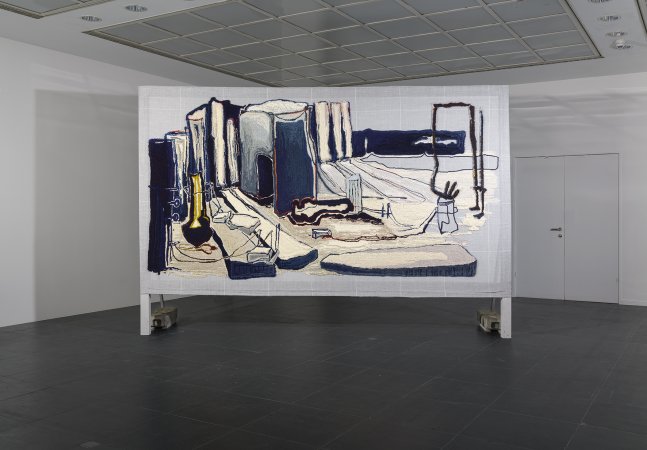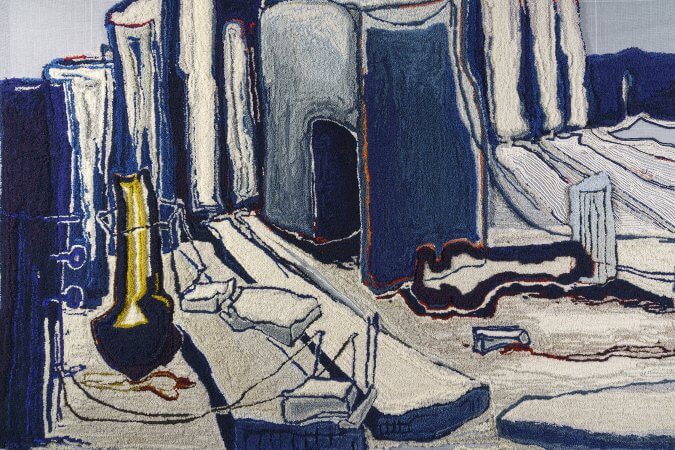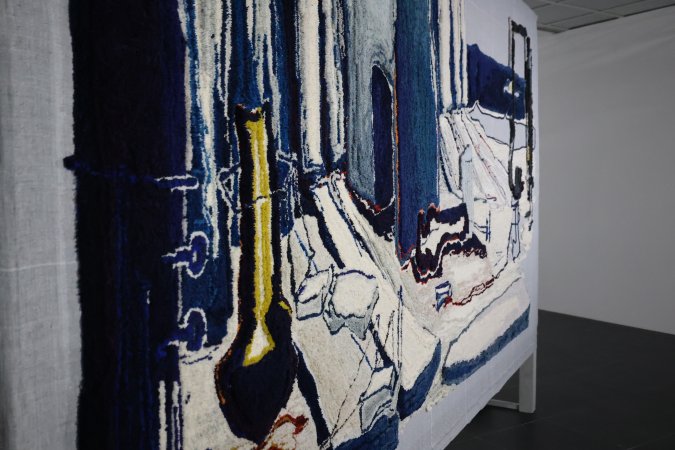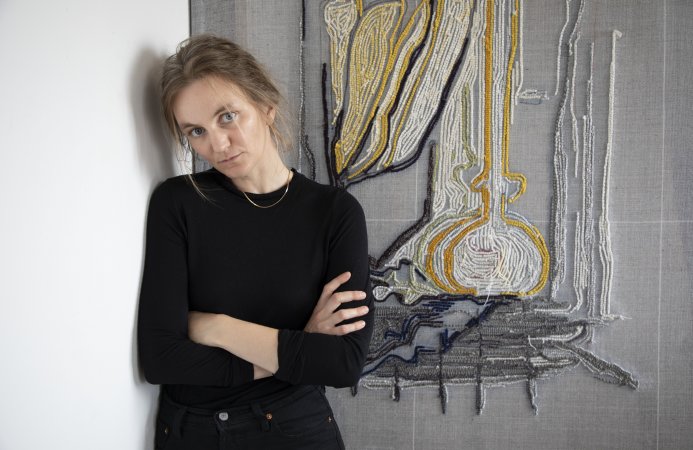Pia Ferm
Capriccio (study), 2023
Handtufted tapestry
Wool, linen and polyester yarn, polyester fabric, textile glue
225 x 420 cm
Courtesy the artist
Pia Ferm draws, sculpts and works with textile materials and with marble. Her works emerge from the act of drawing, which she then transforms into different materials and practices.
The artist has created a large-scale spatial installation, a sculptural textile painting, for the exhibition. For weeks, Pia Ferm worked in a workshop set up especially for her at the Frankfurter Kunstverein in order to produce a monumental format for the first time. The panorama that she has realised shows an abstract, man-made landscape that has emerged from her memories of very different urban places: a building site in the city, a deserted sun-drenched industrial area with flat roofs, an abandoned quarry or a large stone mill. Ferm conceives of these places as freestanding structures, separated by dusty open spaces. She has merged these architectural sites into an ensemble. As in urban spaces, Ferm’s landscape is characterised by compressions and voids.
Pia Ferm’s approach to the realisation of her works is highly planned. She prepares visual ideas as sketches, noting down memories and impressions of colours and forms. Ferm researches a special colour palette to achieve precisely conceived colour blends and nuances by mixing different wool threads. The final shades of colour within a surface are created through work with the individual wool threads that requires considerable time and accuracy.
The artist perceives her working process as experiencing how to understand and control her material. The shapes and surfaces are often contoured by lines. Starting from her drawings, she sets lines and contours on the stretched tufted fabric, which she then fills with expanses of colour and models three-dimensionally. Individual architectural structures seem to draw their shadows and reflections using sunlight. Pia Ferm’s motifs are suspended between the abstract and the figurative and are not formed solely by lines and monochrome surfaces. The textile sculpture is positioned in the space thanks to a supporting structure made of wood, which has served the artist as a tufting frame.
She has been working with the tufting technique for several years. Tufting has been practised since the 1920s with the first tufting machine for the industrialised production of rugs. Tufting works much like a sewing machine: the machine stitches the thick yarn at high speed into the carpet backing. Worked from the back, it creates loops on the front, which are treated and trimmed like a mouldable material to produce three-dimensional textile surfaces. In the industrial process several needles are placed next to each other; Pia Ferm, however, works with a specially developed hand tufting machine that is activated by an air gun and a compressor to sew stitches onto the stretched backing material. The artist also chooses to work with the pistol-like machine to dispel associations with textile production that carry feminine connotations.
Processual handwork is central to her practice: from the careful selection of her materials, to the use of controlled physical movements for the workflow, to the profound knowledge of her material and technical know-how.
Familiar with traditional craft techniques that require time, knowledge and concentrated manual work, Pia Ferm deliberately chooses tufting to create three-dimensional images that she sees simultaneously as drawings, paintings and sculptures. Whether wool, linen, cotton or Cottolin, Pia Ferm always sources her material from family-run companies in Sweden, where it is dyed with natural pigments by a small dye works. The working process is lengthy, dynamic and physically demanding. It consists of constant repetition in terms of looking, shooting, stepping back, looking, shooting and always checking the other side. The creative process becomes an artistic struggle for the final composition.
Pia Ferm (*1986 in Lykesil, SE) graduated in 2020 from the Hochschule für Bildende Künste – Städelschule in Frankfurt am Main (DE) with Prof. Tobias Rehberger. Since then, she has worked with tapestry and marble sculptures. Previously she studied printmaking and painting at the Dômen Artschool in Gothenburg (SE). Venues she has exhibited at include: Galerie Judith Andreae, Bonn (DE), Nassauischer Kunstverein Wiesbaden (DE), Opelvillen, Rüsselsheim, (DE), Museum Villa Rot, Burgrieden (DE), Portikus, Frankfurt am Main (DE), Göteborgs Konstförening, Gothenburg (SE).





